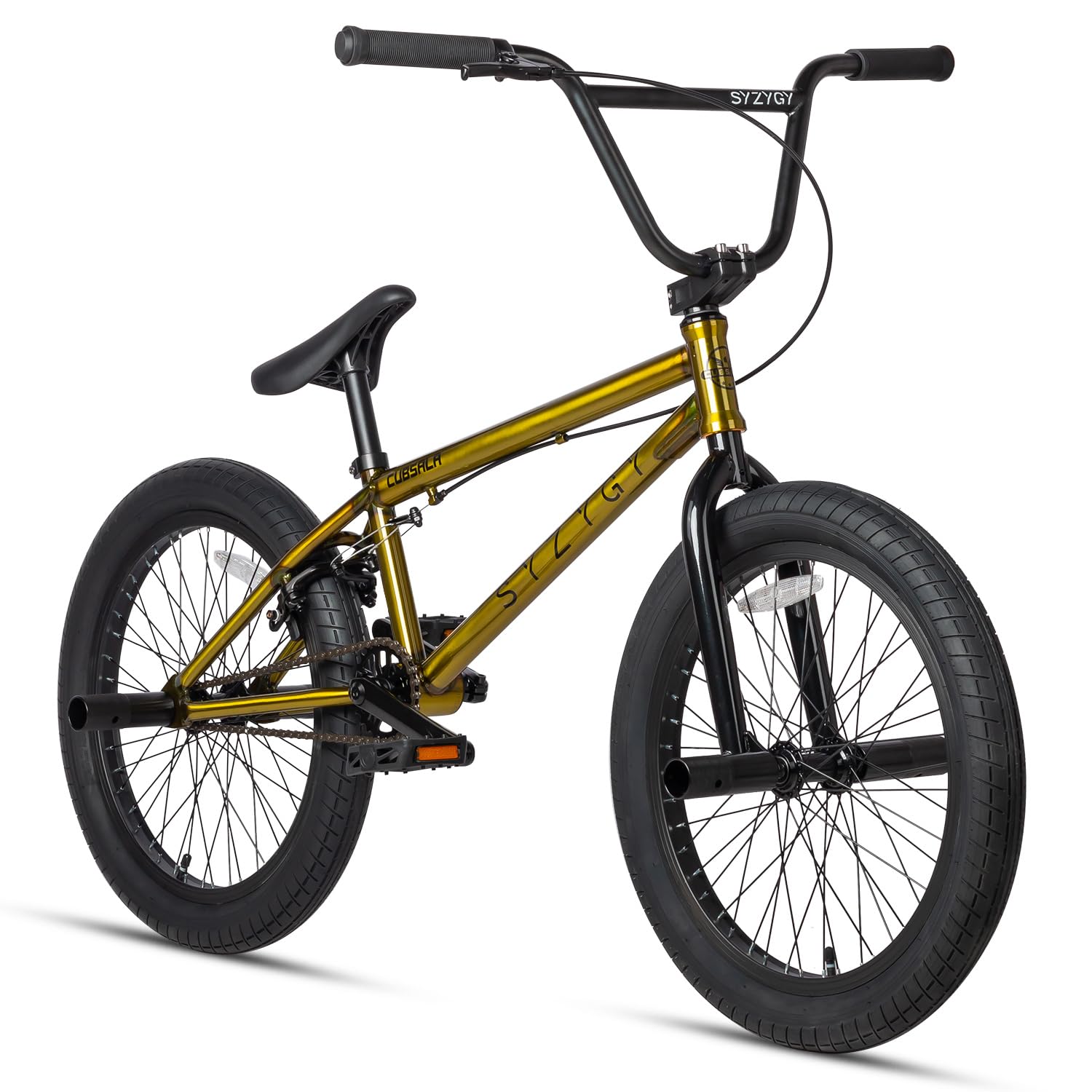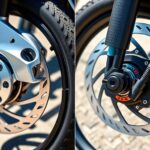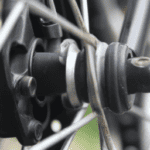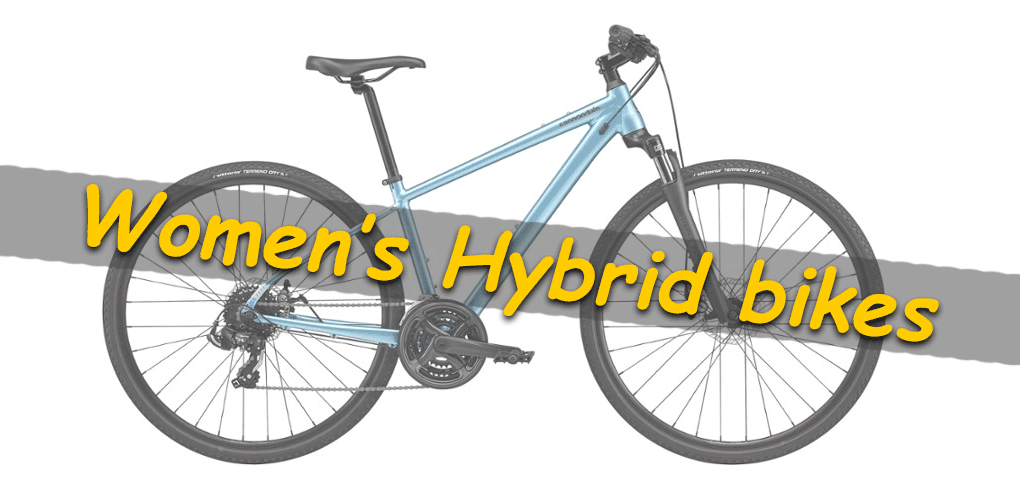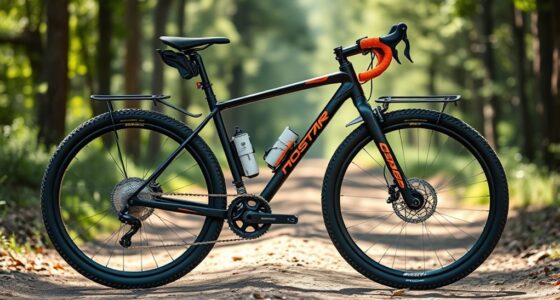When you're choosing between disc and rim brakes for your hybrid bike, consider your riding style and conditions. Disc brakes offer superior stopping power, especially in wet weather, while maintaining better heat dissipation. This means you're less likely to experience brake fade on descents. On the other hand, rim brakes are typically easier and cheaper to maintain, although they may struggle in critical situations. Your choice may also depend on compatibility with your bike's frame. Understanding these key differences can help you make the right decision for your needs, and there's much more to explore about each option.
Key Takeaways
- Disc brakes offer superior stopping power and performance in wet conditions, while rim brakes may fade and struggle in similar scenarios.
- Rim brakes are simpler and less expensive to maintain, but they can wear down wheel rims over time.
- Maintenance for disc brakes is more complex, requiring careful cleaning and potential hydraulic line servicing compared to easier rim brake adjustments.
- Disc brakes allow for wider tire clearances, enhancing versatility, while rim brakes restrict tire width to about 28mm-30mm.
- Current trends favor disc brakes for hybrid bikes, with many new models designed exclusively for disc brake compatibility.
Brake Types Overview
When it comes to choosing brakes for your hybrid bike, what's the difference between disc and rim brakes? Both types offer unique advantages and disadvantages that can affect your riding experience.
Disc brakes are known for their superior stopping power, especially in wet conditions. They dissipate heat effectively, ensuring consistent braking performance no matter the weather, making them particularly beneficial for commuting efficiency in urban environments. This makes them a popular choice for riders facing diverse weather conditions.
On the other hand, rim brakes function by squeezing brake pads against the wheel rims. They're simpler and typically less expensive to maintain, making them appealing for budget-conscious cyclists.
However, rim brakes can fade under prolonged heavy use and struggle in wet conditions, which might compromise your stopping power when you need it most.
Ultimately, the choice between disc and rim brakes for hybrid bikes often comes down to your preferences and intended use. If you prioritize performance in various weather conditions, disc brakes are likely your best bet.
But if you value simplicity and easier maintenance, rim brakes might suit you better. Consider how you ride, and select the brakes that align with your needs.
Performance Comparison

In various riding conditions, the performance of disc and rim brakes can considerably impact your experience on a hybrid bike. If you're contemplating disc brakes vs rim brakes, understanding their performance benefits is essential.
| Feature | Disc Brakes | Rim Brakes |
|---|---|---|
| Braking Power | Superior, especially in wet conditions | Adequate for casual riders in dry conditions |
| Heat Dissipation | Excellent, prevents fade during descents | Prone to fade with heat buildup |
| Modulation & Emergency Stops | Hydraulic disc brakes offer better control and stopping power | Less effective in critical situations |
Disc brakes excel in heat dissipation, which means less risk of brake fade during long descents. They provide reliable braking power for emergency stops, ensuring you can react quickly in critical situations. While rim brakes may suit casual riders in dry weather, they struggle in wet conditions and during prolonged use. If you often ride in varied terrains, disc brakes are a better choice, offering consistent performance and enhanced modulation. Choosing the right brake type can enhance your cycling experience, making it safer and more enjoyable.
Maintenance and Repair
Maintaining your hybrid bike's braking system is as important as understanding its performance.
Whether you have disc brakes or rim brakes, regular maintenance can help guarantee your safety and enhance your riding experience. It's crucial to budget for ongoing maintenance costs and financial mistakes to avoid that can arise from neglecting equipment care.
Here are some crucial maintenance tips to keep in mind:
- Brake Pads: Regularly check your brake pads for wear. Disc brake pads may need occasional inspection despite their self-adjusting features, while rim brake pads require manual adjustment.
- Cleaning: Be cautious when cleaning disc brakes to avoid contaminating the pads and rotors. Rim brakes can handle a wider range of cleaning products without damage.
- Servicing: Disc brakes typically require more complex servicing, including bleeding hydraulic lines and sometimes specialized tools. Rim brakes are easier to maintain, making pad replacement and adjustments more straightforward.
Cost Considerations

Considering the financial aspects of your hybrid bike's braking system is essential for making informed decisions. When weighing cost considerations, rim brakes generally offer lower upfront costs and maintenance expenses, making them a more budget-friendly choice for casual riders.
However, if you're a serious cyclist who faces varied riding conditions, investing in disc brakes might be worthwhile. Although they come with higher initial costs, the performance benefits can justify the expense. Additionally, it's important to establish a budget that accommodates these expenses, similar to creating a retirement savings plan where setting clear goals is vital for financial stability establish clear savings goals.
Keep in mind that top-quality disc brake components can take up a significant portion of your budget—20% or more—which may force you to compromise on component quality in the lower price ranges. If you're looking for better value without sacrificing too much, consider last year's models. They often come with excellent features, allowing you to find quality options in either rim or disc brakes that fit your budget constraints.
Ultimately, decide what's more important: saving money upfront with rim brakes or investing in disc brakes for enhanced performance over time. By carefully evaluating these cost considerations, you can choose the braking system that aligns best with your riding style and financial situation.
Brake Mechanisms Explained
Understanding the differences between brake mechanisms is vital for enhancing your hybrid bike's performance. When it comes to bike brakes, you typically have two main options: disc brakes and rim brakes. Each system has its own unique features and benefits.
For instance, high-performance top projectors for gaming can greatly enhance your viewing experience, similar to how effective braking systems improve bike handling.
- Disc brakes apply braking force to a rotor mounted on the wheel hub, enhancing modulation and stopping power.
- Rim brakes are lighter and easier to service, thanks to their simpler components and minimal maintenance needs.
- Hydraulic disc brakes use fluid pressure to activate brake calipers, offering superior performance with less force needed from you.
On the other hand, mechanical disc brakes operate through a cable system connecting the brake lever to the caliper. While they can be effective, they may suffer from issues like cable stretch and dirt ingress, which can impact performance.
It's imperative to take into account the compatibility of disc brake systems, whether post-mount or flat-mount, with your bike frame and components to guarantee ideal installation.
Safety and Performance

When it comes to safety and performance, the choice between disc and rim brakes can greatly impact your riding experience.
Disc brakes provide superior stopping power, especially in wet conditions, minimizing the risk of brake fade during prolonged use. This advantage makes them a safer option for emergency stops and technical riding, where quick, reliable braking is essential. Additionally, factors influencing their effectiveness include the type of system and terrain, much like how home security system costs can vary based on installation and features.
Hydraulic systems in disc brakes enhance modulation, allowing you to apply just the right amount of pressure without excessive hand effort.
On the other hand, rim brakes can wear down the wheel rims over time, potentially compromising your safety. Disc brakes maintain cleaner rims and reduce the need for frequent replacements.
Heat dissipation is another key factor; disc brakes excel in this area, considerably lowering the chances of overheating during steep descents—something that rim brakes often struggle with.
Additionally, the performance of disc brakes remains consistent across diverse terrains and weather conditions, while rim brakes may require more frequent adjustments and maintenance to guarantee ideal safety.
Ultimately, the choice between disc and rim brakes can greatly influence your overall riding experience and peace of mind.
Frame Compatibility

Designed with specific brake systems in mind, hybrid bikes typically offer either disc or rim brake compatibility, which means you can't easily switch between the two without significant modifications. This limitation affects your options when considering upgrades or changes to your braking system.
Understanding the compatibility of your bike's frame can be as vital as tuning a vehicle for peak performance, especially when considering GMC tuning enhancements.
When evaluating frame compatibility, keep these points in mind:
- Tire Clearances: Disc brakes generally allow for wider tire clearances, making them more versatile for various terrains and accommodating wider tires commonly found in hybrid designs.
- Brake Systems: Rim brake calipers restrict tire width to about 28mm-30mm, limiting your choices if your bike is set up for rim brakes.
- Upgrading Complexity: If you decide to upgrade to disc brakes, you'll need a compatible frame and components, plus new wheelsets designed for disc mounting, which adds complexity and cost.
As the market shifts towards disc brakes, many new hybrid bike models are being released exclusively with this compatibility.
Current Trends in Braking

As you explore your hybrid bike's braking options, it's clear that the landscape is shifting towards disc brakes. These brakes are favored for their superior performance across various terrains and weather conditions, especially during wet rides or steep descents.
Major bike brands are increasingly releasing disc-only groupsets, highlighting an industry trend that prioritizes disc brake technology over traditional rim brakes. This trend mirrors the growing emphasis on preparedness and resilience in various contexts, including biking, similar to how we approach emergency preparedness essentials.
Despite this shift, rim brakes still hold their ground among traditionalists who appreciate their simplicity and ease of maintenance. However, the rise of hydraulic disc brakes can't be ignored. These systems offer enhanced stopping power and improved modulation, making them a top choice for serious cyclists on road bikes and gravel bikes alike.
Advancements in disc brake technology continue to enhance their reliability and safety, ensuring they remain at the forefront of cycling.
As you consider your braking options, remember that disc brakes aren't just a trend; they represent a significant evolution in cycling technology, promising better performance and control.
Whether you're a casual rider or a dedicated enthusiast, understanding these trends will help you make an informed choice for your hybrid bike.
Budget and Buying Tips

When you're setting your budget for a hybrid bike, aim for around $500 to guarantee you get good quality components without overspending.
It's also wise to think about your long-term needs, just as planning for future care can help avoid financial burdens later on, such as those outlined in estate planning.
Consider prioritizing component quality over fancy brake types, as investing in better parts often pays off more in the long run.
Remember to assess your riding needs, as this will help you make the best choices for your bike.
Assessing Your Budget
Setting a budget for your new hybrid bike is essential to guarantee you get the best value without overspending. Aim for a maximum of $500 to balance quality components and brake systems.
While disc brakes or rim brakes may be a consideration, investing in upgraded components might provide more value at this price point. Good rim brakes can often perform better than lower-quality disc brakes, so think carefully about your personal riding needs.
Additionally, consider how potential tax implications of inherited IRAs might affect your long-term financial planning when making a significant purchase like a bike.
Here are a few tips to help you assess your budget:
- Look for discounts during off-peak sales seasons.
- Explore used bikes to find higher-quality components.
- Be aware that quality hybrid bikes typically start around $800.
Prioritizing Component Quality
Prioritizing component quality is key to getting the most out of your hybrid bike purchase. When you're working with a budget under $500, focusing on better components can greatly enhance your bike's performance and durability.
While disc brakes may seem appealing, they can consume over 20% of your budget, limiting the investment in other essential parts. Instead, consider rim brakes paired with high-quality components to balance performance and value.
Additionally, exploring options like top rated vacuums can provide insights into how component quality affects overall satisfaction with products.
Last year's models often offer improved components at a lower price, making them a smart choice for budget-conscious buyers. Don't overlook used bikes; they can provide superior components for a similar price, allowing you to secure a better quality bike without stretching your budget.
Before making a decision, invest time in research and take test rides. Understanding your cycling needs will help you choose between braking systems and prioritize component quality effectively.
Frequently Asked Questions
Are Disc Brakes Better on a Hybrid Bike?
When considering brake options, you'll find disc brakes offer superior stopping power and performance in various conditions. They might require more maintenance, but their long-term benefits and adaptability often outweigh the initial costs for hybrid riders.
Are Disc Brakes Better Than Rim Brakes on a Bicycle?
When you consider braking systems, you'll find disc brakes offer superior stopping power and consistent performance, especially in wet conditions. While rim brakes are simpler and cheaper, they can wear out quickly and require more maintenance.
Why Do People Prefer Rim Brakes?
You might prefer rim brakes because they're cost-effective, easier to maintain, and lighter. Their familiar design offers reliable stopping power in dry conditions, making them user-friendly for casual riders like you. Experience matters too!
What Are the Disadvantages of Disc Brakes?
Disc brakes can be more expensive upfront and require complex maintenance, which can be time-consuming. They're also heavier, may overheat during long rides, and compatibility issues could limit your bike choice.
Conclusion
When choosing between disc and rim brakes for your hybrid bike, it's crucial to weigh performance, maintenance, and cost. Think of your bike's brakes as its heartbeat; they keep you safe and in control on every ride. Opt for the type that suits your style and needs, and you'll enjoy countless adventures. Remember, investing in the right brakes isn't just about stopping; it's about embracing the freedom of the open road. Happy cycling!

